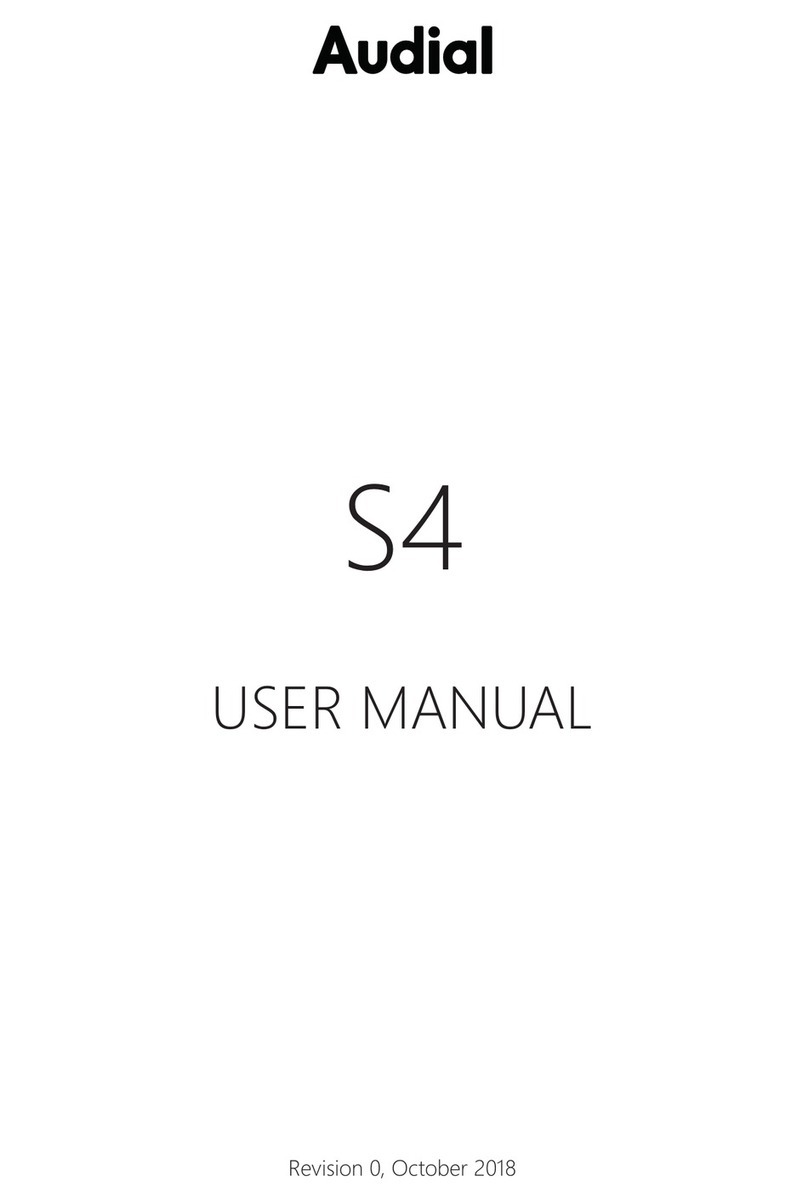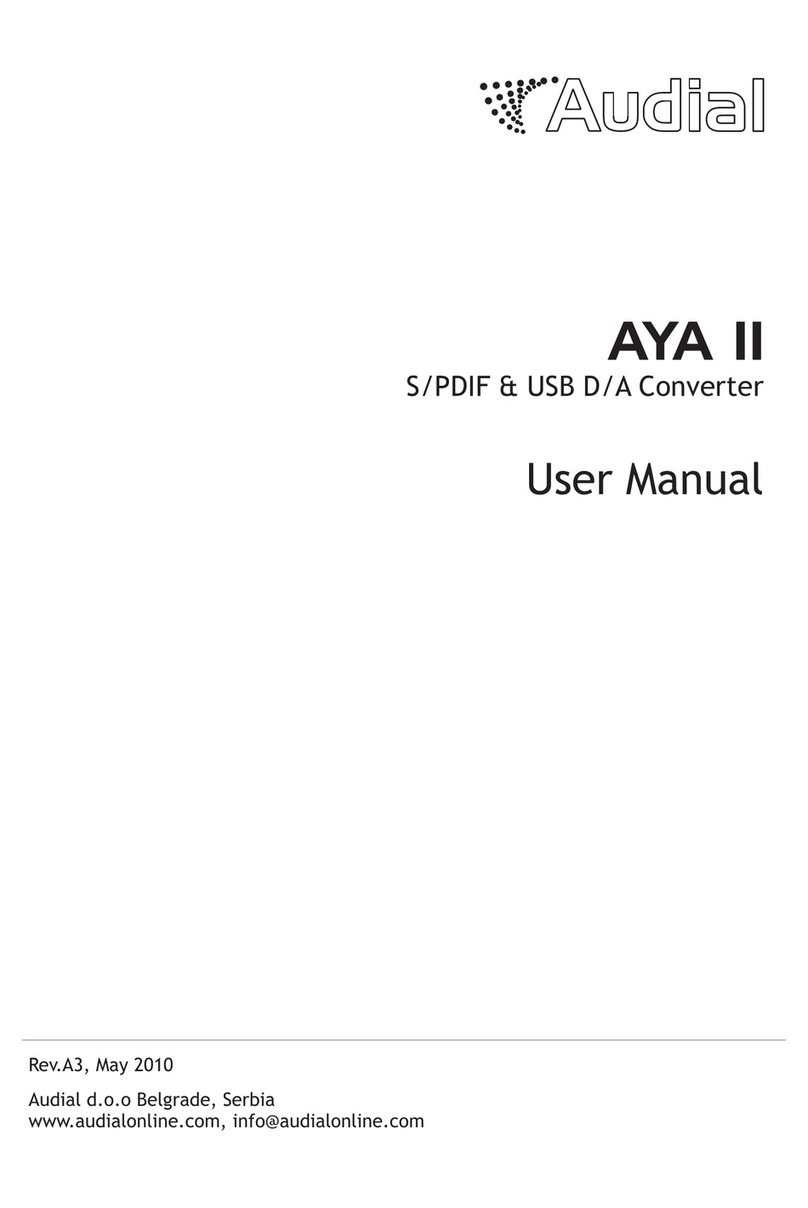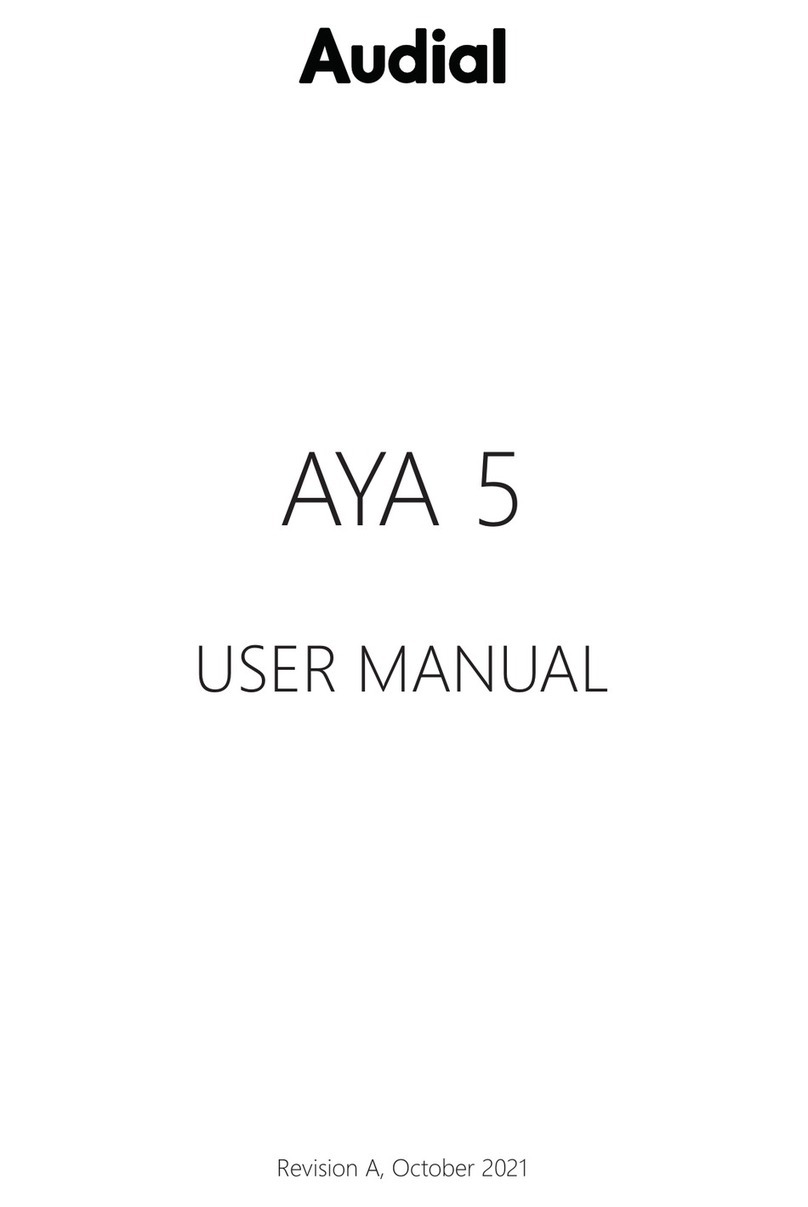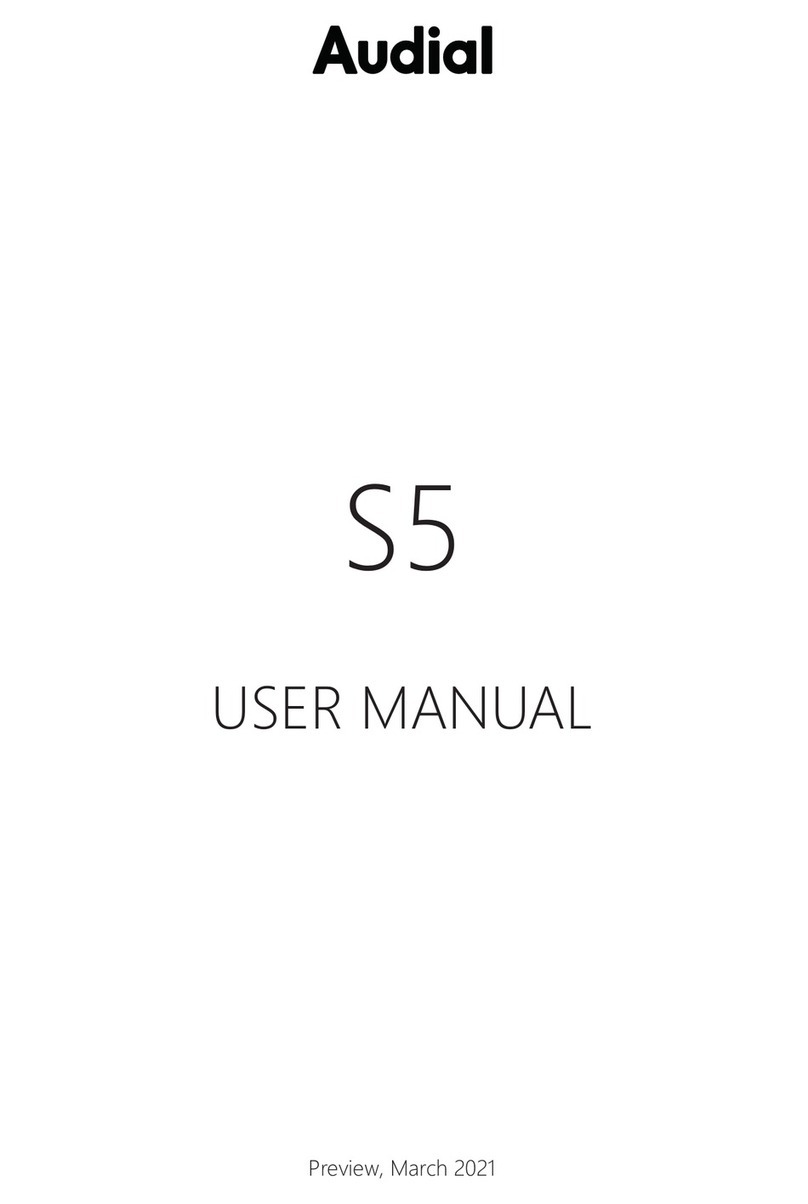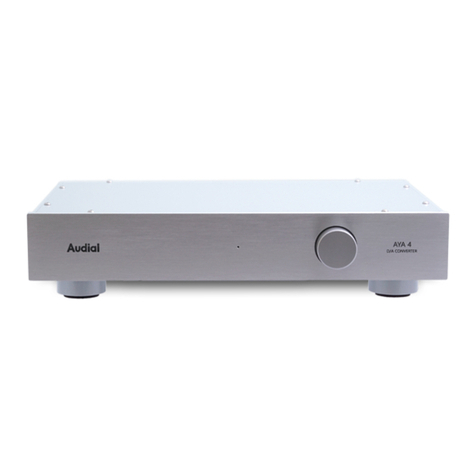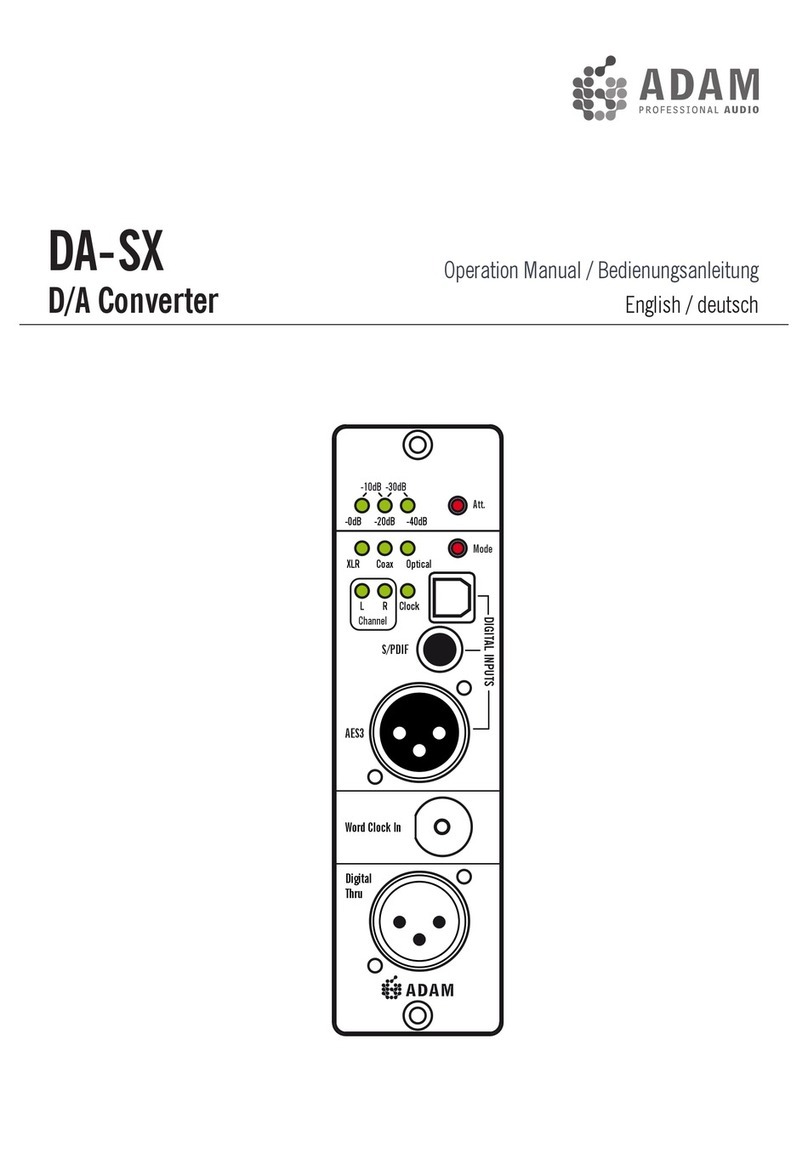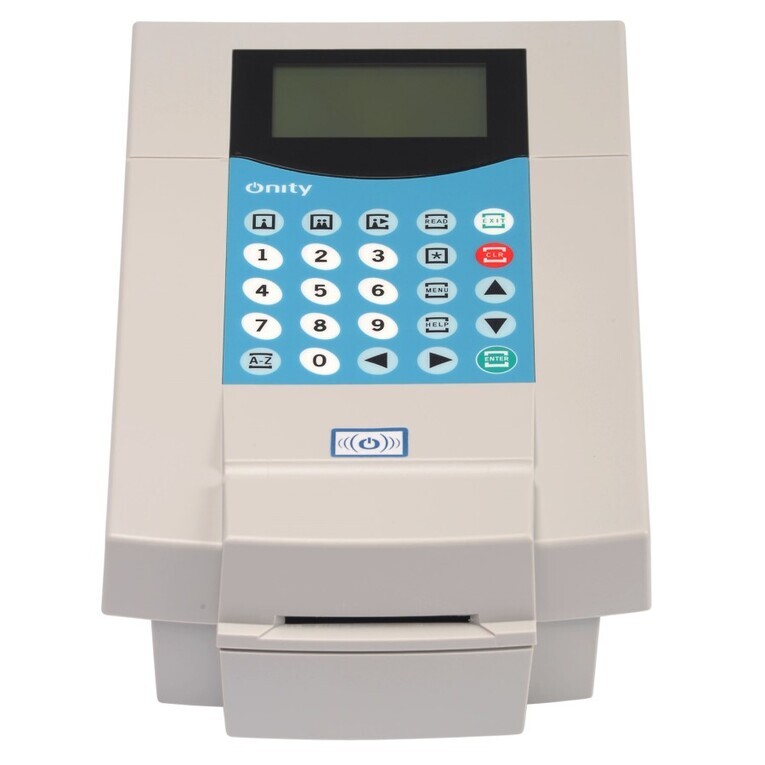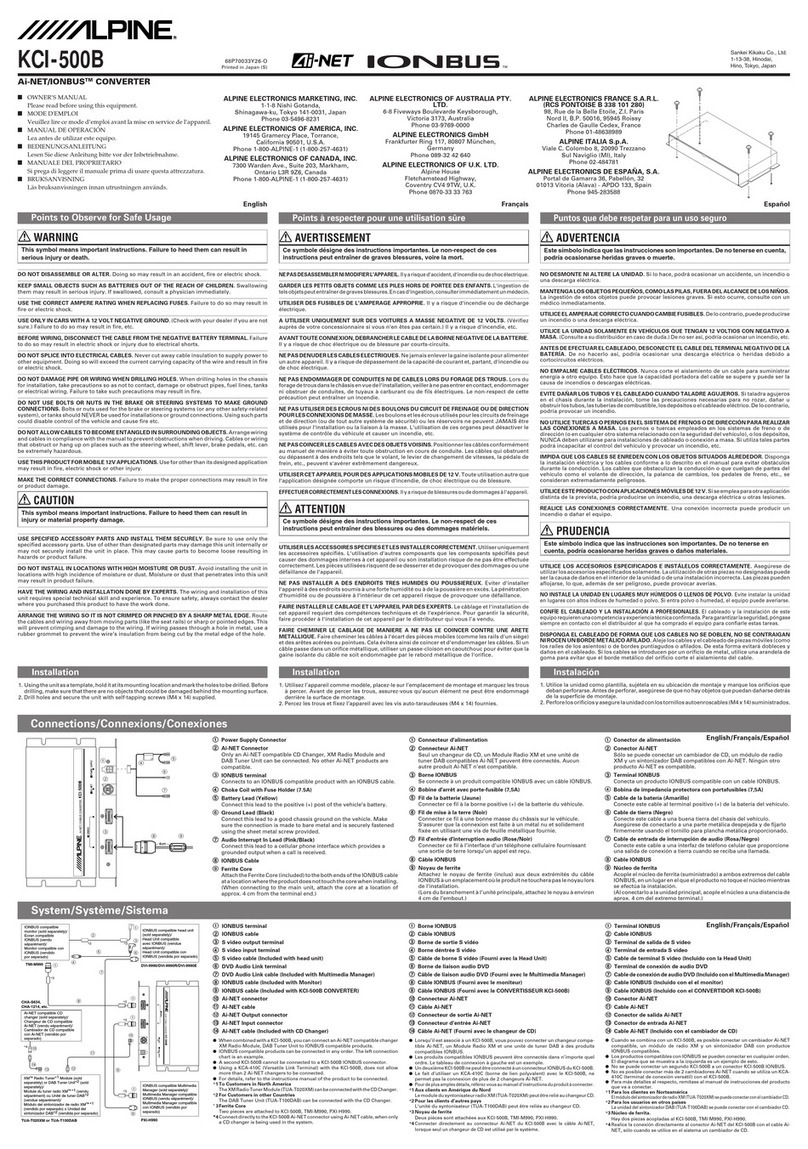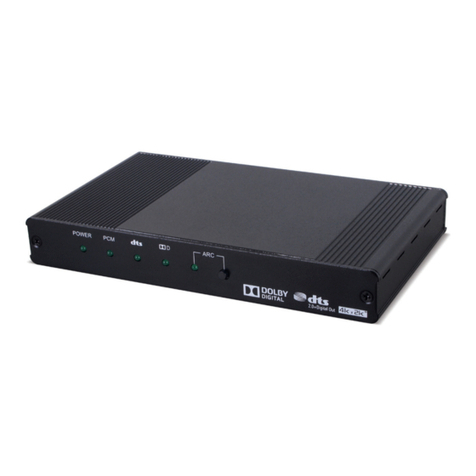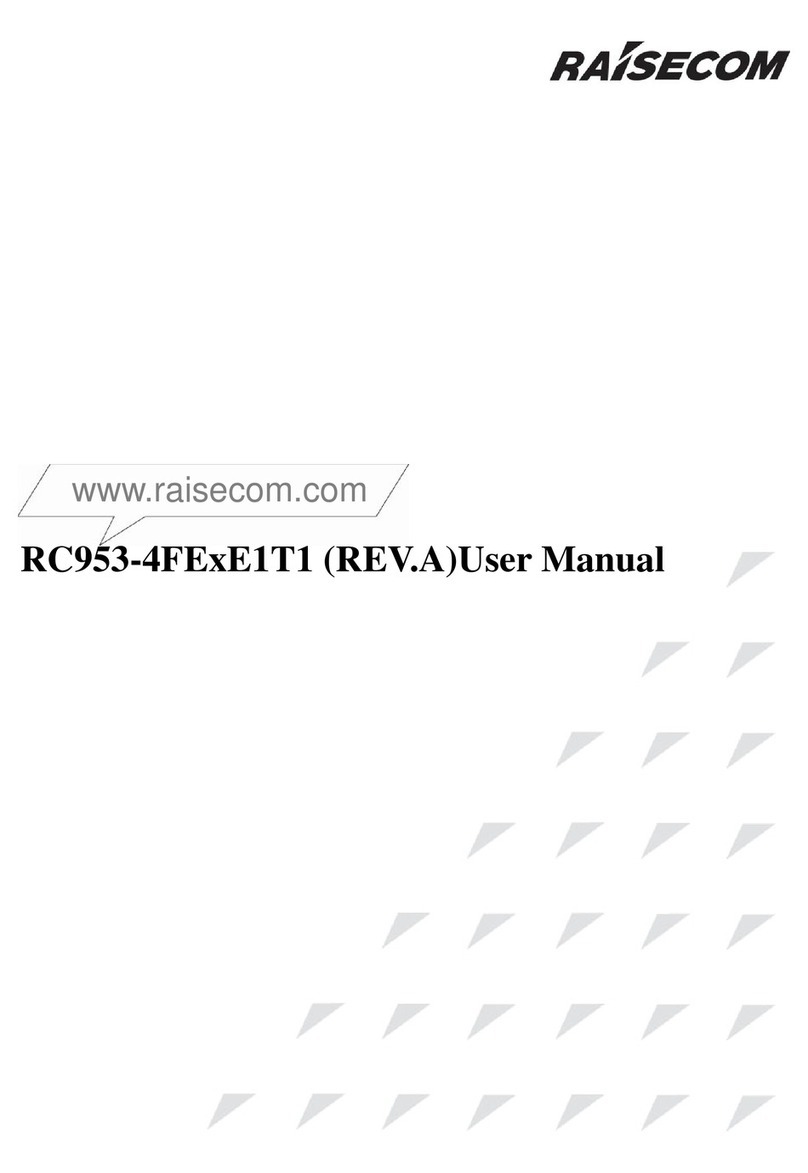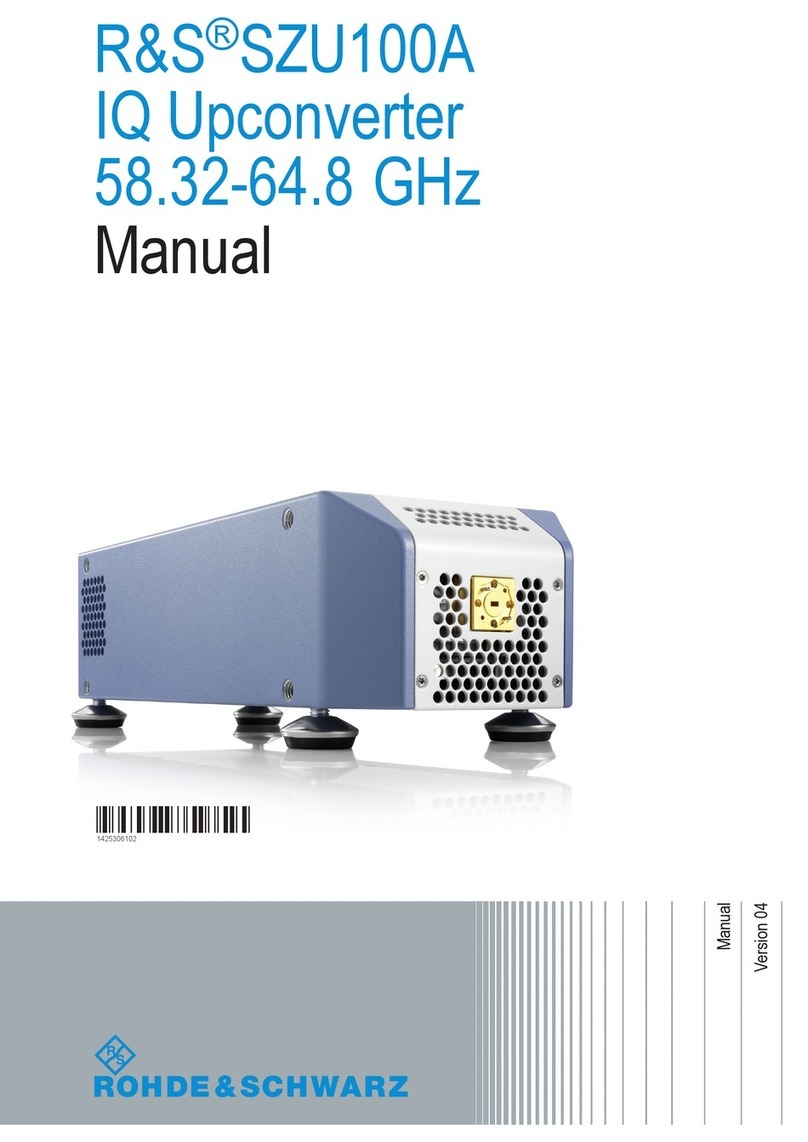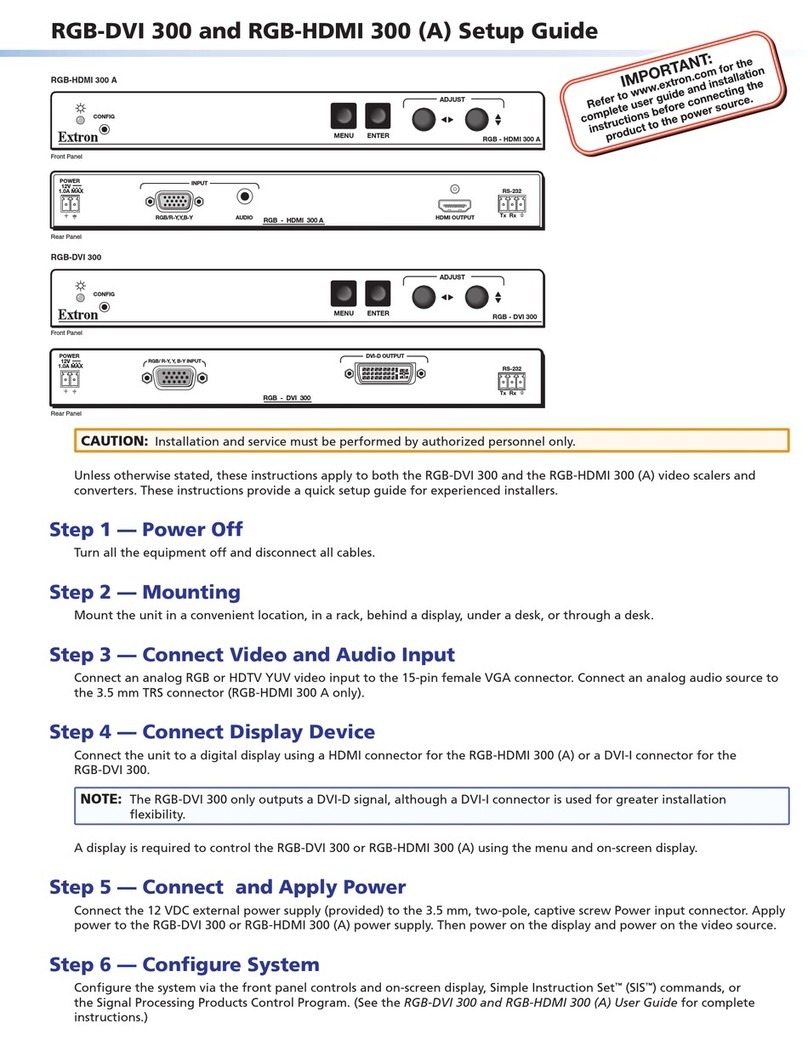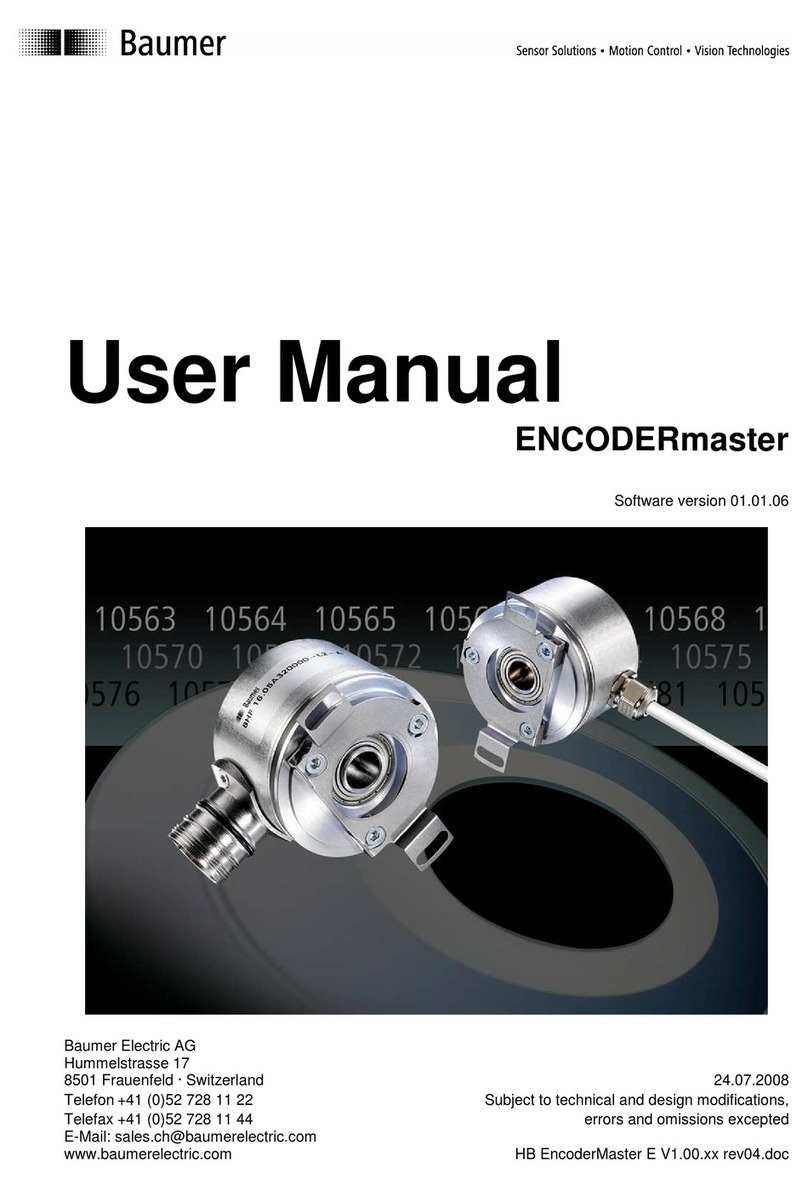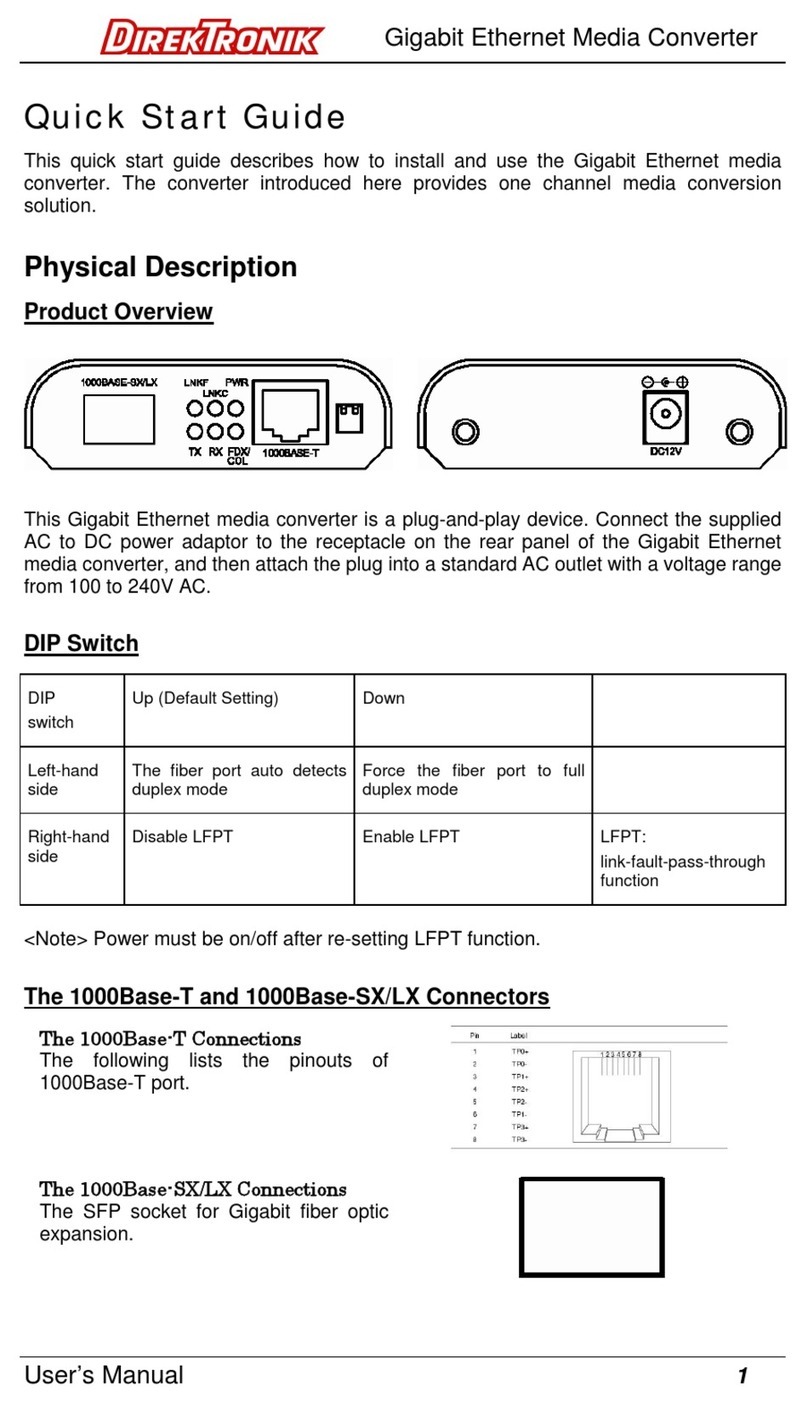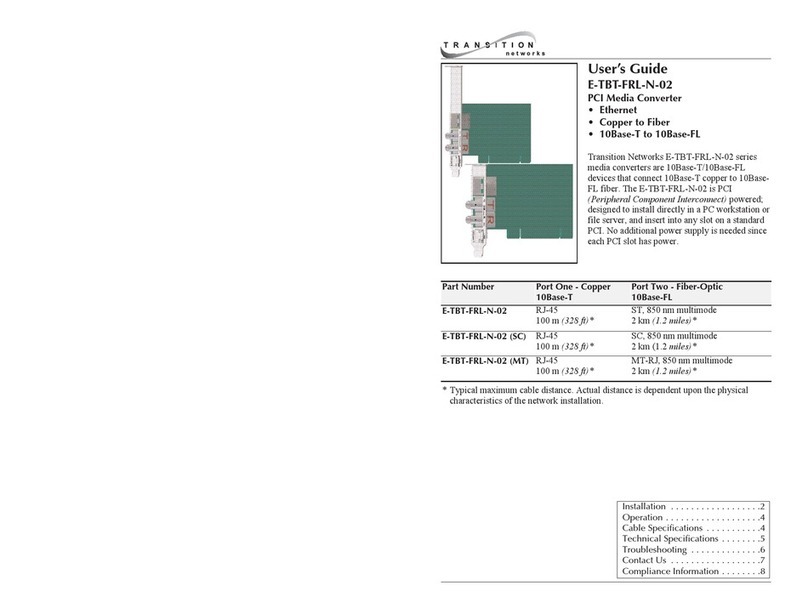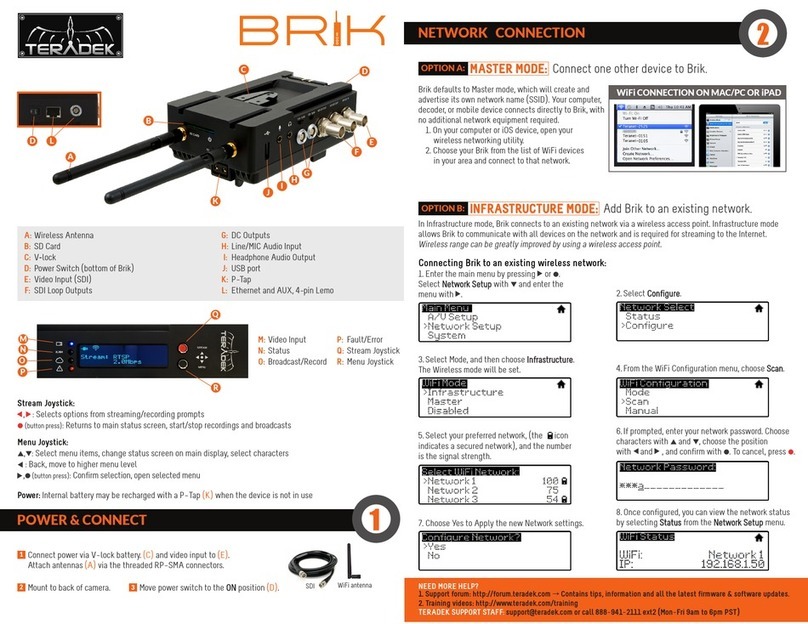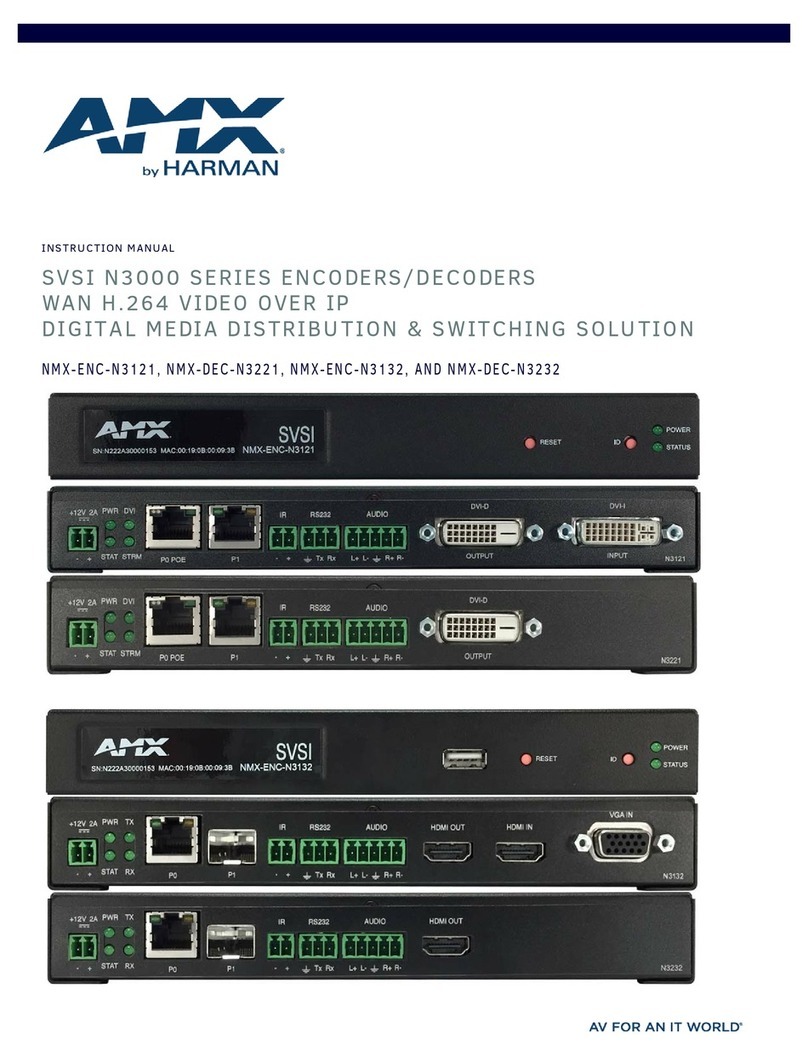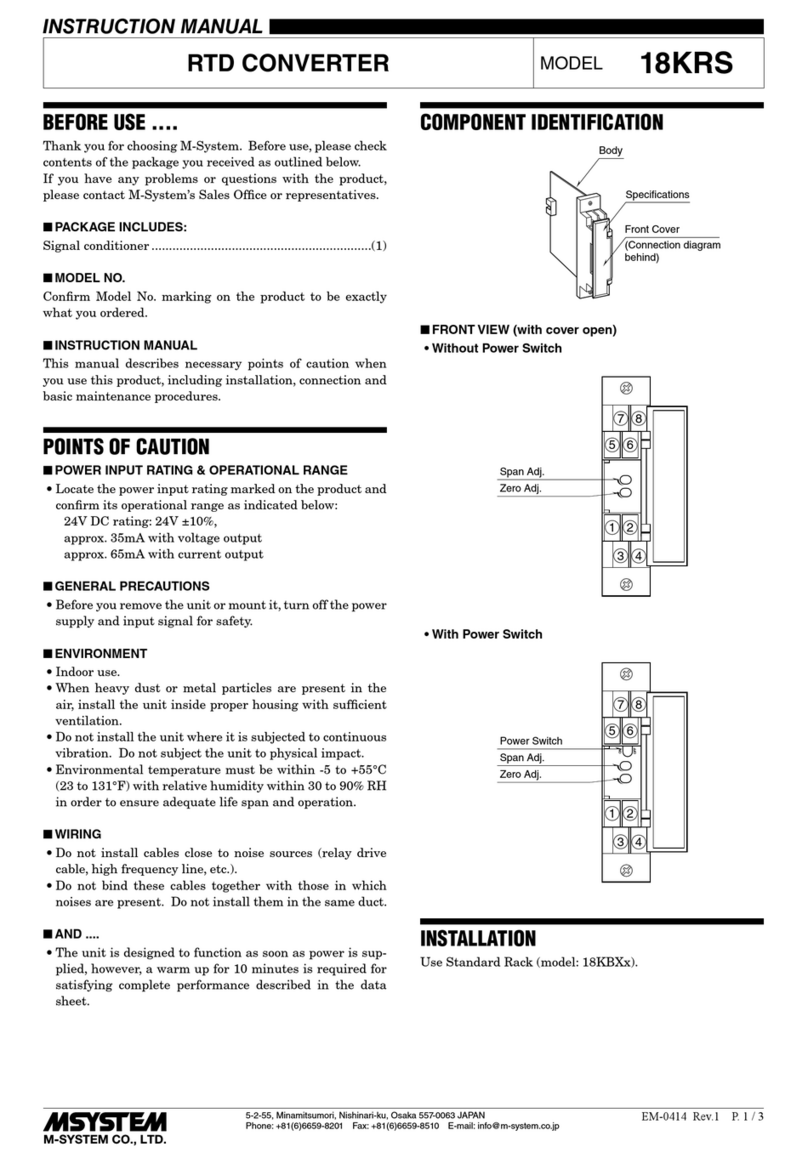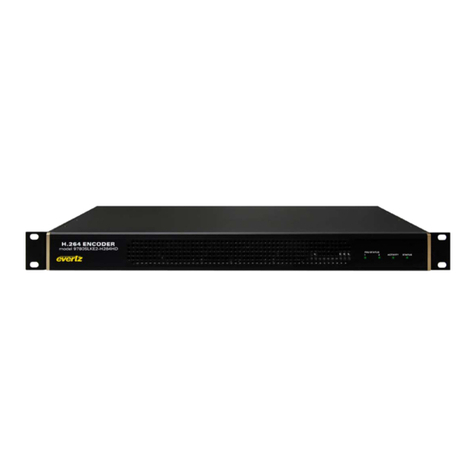Audial USB board Mk2 User manual

USB board Mk2
INSTRUCTION MANUAL
Revision 0, December 2017

IMPORTANT!
1. This manual is a guide only.
2. Device is claimed to work as such, however the customers are responsible for their applications.
3. Do not expose this device to rain or moisture, excessive heat or mechanical force.
4. Use this device exclusively with specified voltages.
5. Unplug the device from the wall outlet during a lighting storm.
Copyright © 2017, Audial d.o.o.
www.audialonline.com
This manual comprises introducing information on use and performance of this device. For more
information please refer to the Audial web site, or send your questions to [email protected].

THIS DEVICE
Audial USB board is a USB audio decoding stage,
which also generates clock signal for D/A conversion.
At one side it connects to PC via USB port and, by
operating as asynchronous (master) USB Audio Class
2.0 device, it is able to accept audio sampling rates up
to 192 kHz. Up to 384 kHz operation is available as
optional feature.
The board decodes USB signal to raw PCM that can be
sent to D/A chips. Also, it provides galvanic decoupling
between USB and PCM side, thus also separating PC
from audio clocks and other audio circuits.
Two low jitter clocks are included, one that works with
44.1/88.2/176.4 kHz, and the other that works with
48/96/192 kHz sampling frequencies. This way the unit
achieves clean clocking scheme, and all the audio
clock signals in the system are generated only by
frequency dividing, and not by using PLL synthesizers.
MARK 2
The Mk2 board version is shipped as a ready made
module, or as completed unit.
Modules are intended for use inside or close to the
D/A converters, and output signal is available on the
set of nine U.FL PCB connectors. These U.FL outputs
are 3.3 V level, with 50 Ohm build-out resistors, and
they can drive several gates, but are not meant to drive
terminated lines. Modules do not include BNC output
connectors, nor do they include associated line
drivers.
Module requires transformer with two secondary
windings: one 7-8 VAC (AC1) for USB front end, and
one 8-10 VAC (AC2) for clocking and output side. AC1
can be up to 10 VAC too, but transistor Q1 (BD139,
TO-126 package) should have some heatsink in that
case.
Transformer should be capable to supply 500mA, for
both AC1 and AC2. The current actually needed by
AC1 is 100 mA typically (120 mA max). The current
needed by AC2 is normally 20-30 mA, but if BNC
outputs are added to drive terminated lines, it will
increase to about 100 mA. Overall, a small 10 VA
transformer is enough to feed this module, and 20 VA
is plenty, under any circumstances.
Completed unit includes line output drivers, and PCM
signal, including the master clock, is available on the
set of BNC connectors, located along the right side of
the unit. BNC outputs are typically 5 V level, 75 Ohm
series terminated, and with 75 Ohm load they will
provide 2.5 V at receiving end, but on request they can
be set for 3.3 V output too.
3
Audial USB board Mk2

4Audial USB board Mk2
USB AUDIO CLASS 2.0
This USB device employs USB Audio Class 2.0
definitions.
Mac OS X and Linux are natively USB Audio Class 2.0
compliant for several years now, and this device hence
does not require special driver when used with Mac OS
X or Linux.
WINDOWS USB AUDIO CLASS 2.0
Since September 2017, Windows 10 also supports
USB Audio Class 2.0 definitions. This basically makes
this device plug and play with Windows 10, and once it
is connected to Win 10 machine, the small window will
pop up in the bottom right corner of the screen,
reporting about the initial connection routine. Once
this process is finished, the device can be found as
playback audio device, available in the system.
DEDICATED WINDOWS DRIVER
Audial provides dedicated Windows driver for this
device, which is still necessary with earlier Windows
versions. Also, this driver provides additional
functionality as firmware update, ASIO interface,
buffer length control, and can be generally preferred
soundwise.
Users can download this driver from Audial web site.
Driver version 1.26 can be installed to Windows XP,
Vista, 7, 8, 8.1 and 10. Later driver version 2.10
however improves on compatibility with later PC
systems, and can be installed to Windows 7, 8, 8.1 and
10. All driver versions are compatible with both 32 and
64-bit Windows.
To install the driver, please unzip provided file, and run
setup.exe. Installation window will pop up, and at one
stage you will be asked to connect the device. Also,
during this process, depending on your Windows
version and security settings, you might be asked a
couple of times to allow the installation, so please do
so. These windows will look like this.
Once the installation is complete, you can configure
your settings by using the control panel, available in
Windows Start Menu -> Audial.

5
Audial USB board Mk2
OUTPUT FORMATS
Depending on the firmware, this board may output
one of the following digital protocols.
A. Philips simultaneous data protocol
This protocol is intended for use exclusively with
TDA1541(A). The output has split channels, 16-bit
right justified data, in offset binary format, clocked on
the falling edge of BCK. Negative data outputs are also
provided, so the board can be used as a source for true
balanced TDA1541(A) DAC.
B. I2S/ SPDIF
I2S is as specified, so two data channels are time
multiplexed, and binary word starts one BCK cycle
after WS transition. Data is in two’s complement
format, and is clocked on the raising edge of BCK. In
addition, the board with I2S output also has an S/PDIF
output.
C. PCM1704 format
Similarly to firmware A, this option has split channels,
and right justified data. The word is however 24-bit
long, data is in two’s complement format, and it is
clocked on the raising edge of BCK.
Output formats are graphically shown on the figure 4
(page 9).
OUTPUT CONNECTIONS
The table below shows detailed list of the signals
available on the set of nine U.FL connectors (J202 -
J210). The same applies to the BNC output connectors
of the completed unit, and the only exception is that
there is only one BNC connector per BCK and LE / WS
line.
In I2S mode, 75 Ohm S/PDIF output is available at BNC
connector J201, on the back side.
Connector
Output format
Simultaneous data
I2S / SPDIF
PCM1704
DL (J202 / J301)
Left channel data
x
Left channel data
DLN (J203 / J302)
Left channel inverted data
x
Left channel inverted data
DRN (J204 / J303)
Right channel inverted data
x
Right channel inverted data
DR / DATA (J205 / J304)
Right channel data
Data
Right channel data
BCK (J206 / J305)
Bit clock
Bit clock
Bit clock
BCK (J207)
Bit clock
Bit clock
Bit clock
LE / WS (J208 / J306)
Latch enable
Word select (a.k.a. LRCK)
Latch enable (WCLK)
LE / WS (J209)
Latch enable
Word select (a.k.a. LRCK)
Latch enable (WCLK)
MCK (J210 / J307)
Master clock
Master clock
Master clock

6Audial USB board Mk2
MAXIMUM SAMPLING RATES
At its input, this device is generally 192 kHz
compatible, however maximum output sampling
frequency might be limited by the reclocker, and its
requirements regarding the master clocks frequencies.
Table below shows detailed specifications.
Please note that the TDA1541, both -A and non -A
versions, can normally work up to 192 kHz in
simultaneous data mode, however in I2S it is limited to
96 kHz in any case.
UP TO 384 KHZ COMPATIBILITY
Firmware version 3.5 has been released in September
2017, to add 352.8 kHz and 384 kHz compatibility to
the boards with TDA1541(A) simultaneous data
output and 22.5792 / 24.576 MHz master clocks.
Please note that the Windows audio is currently limited
to 192 kHz, however the operation at 352.8 kHz and
384 kHz is possible by means of ASIO or WASAPI
(exclusive mode) interface.
Also, while non -A version of TDA1541 chip will
normally work up to 384 kHz, a TDA1541A will need a
small tweak. Please contact us for detailed
information.
Master clock frequencies
Firmware
Maximum sampling rate
Simultaneous data
I2S
S/PDIF
PCM1704
11.2896 / 12.288 MHz
3v3
192 kHz
96 kHz
96 kHz
192 kHz
22.5792 / 24.576 MHz
3v3
192 kHz
192 kHz
192 kHz
192 kHz
22.5792 / 24.576 MHz
3v5
384 kHz
N/A
N/A
N/A

7
Audial USB board Mk2
THIS BOARD AND AYA II 2014 / DS
This board can be easily connected to AYA II DAC
projects released in 2014 and 2015 (DS).
Both USB board and AYA II 2014 / DS can operate in
both Philips simultaneous data and I2S mode. AYA II
2014 / DS can accept either simultaneous data
protocol or I2S at the input connectors J301-J304. At
the input connectors J305-J307 it can accept only I2S.
USB board output mode is defined by its firmware. AYA
II i.e. TDA1541A mode is set by TDA1541A pin 27, and
for simultaneous data mode it should be tied to -5
VDC (pin 26), whereas for I2S it should be tied to +5
VDC (pin 28). This can be done either by PCB DIP
switch or by wire jumper. Switch is recommended
though, so the mode can be easily changed later.
Preferred mode of operation is simultaneous data
mode, for better intrinsic jitter performance of
TDA1541(A).
Please however note also that the AYA II can not switch
automatically between two modes, so if you settle on
simultaneous data mode, you will have to change its
mode manually to I2S whenever the other input
(S/PDIF or external I2S) is used.
Before connecting this board to AYA II, the connection
between AYA II on-board USB stage and its input
switching relays must be cut. This can be done by
removing (or by pulling up one side of the) resistors
R118-R120. This way the U.FL connectors J301-J304
are ready to accept external source.
In addition, is also the good idea to turn AYA II on-
board USB stage completely off, by disconnecting its
secondary winding AC1.
In simultaneous data mode the connection between
two boards is achieved by four U.FL cables (Data L,
Data R, BCK, LE), while I2S requires three U.FL cables
(Data, BCK, WS).
By making these connections, the whole set-up is
ready for operation.
Two boards should be placed one beside the other,
into the same plane, and not one above the other.
AYA II 2014 / DS DEM CLOCKING
To determine right DEM clocking frequency, it is
important to know what sets its bottom and upper
limit. Firstly, a DEM clock frequency is divided by four
internally by TDA1541A, and this divided-by-four
frequency should never fall into the audio band,
because it can produce the glitches of its own. So,
practical bottom limit is 80 kHz. On the other side,
TDA1541A performance slightly decreases, as DEM
frequency increases. While this decrease is in fact not
huge, and occurs mostly at the bottom end of the
audio spectrum (0.5 dB at 100 Hz, for 400 kHz DEM
frequency), it is wise to keep the DEM frequency below
500 kHz.
The AYA II DS on-board DEM clocking circuit takes the
bit clock signal, and divides it by 16. This way, in
simultaneous data mode (32 bit frame) the DEM
frequency will be two times higher than audio
sampling frequency, while in I2S (64 bit frame) the
DEM frequency will be four times higher than audio
sampling frequency. In all these cases, and taking into
account the range of operation that applies to each
mode, the DEM frequency will always remain between
88.2 kHz and 384 kHz. Therefore, when AYA II DS is
used with this module, its DEM clocking circuit can be
left as is.
In the AYA II 2014 this synchronous DEM clocking
circuit is optional, but users can employ it the same
way it is used in the AYA II DS.
Of course, since this module offers also a master clock
output, this clock frequency, adequately scaled down,
can be also used as a basis for TDA1541A DEM circuit.

8Audial USB board Mk2
Fig 3: Recommended rear panel cut-out, rear view (all measures in mm)
LED INDICATORS
The board offers connections for three indicating LE
diodes. D10 indicates the board power supply (it is
connected to R5-R6/C4, fed by AC2), D101 indicates
the USB cable connection (it is connected to USB
Vbus), while D102 indicates the audio stream i.e.
playback (flag comes from decoding processor).
BOARD SIZE AND MOUNTING
The board size is 110 mm (width) x 120 mm (depth).
There are four mounting holes, each 4 mm in diameter,
located 5 mm from the board back, left and front
edge, and 25 mm from the right edge.
Center of USB connector is 27 mm from left edge of
the board. Center of S/PDIF output BNC connector
(applies to boards with S/PDIF output) is 67 mm from
the left edge of the board.
To determine heights of the holes at the back plate
required for these connectors, please consider not
only PCB stand-offs, but also PCB itself, which is 1.6
mm thick. The drawing below shows recommended
BNC and USB connectors panel cut-out (rear view),
taking into account 15 mm stand-offs at that.

Fig 4: Top side of the board.
The picture shows USB input connector (J101), S/PDIF output connector (J201),
U.FL output connectors (J202 - J210), BNC output connectors (J301 - J307)
transformer connections (AC1, AC2), LED indicators (D10, D101, D102),
and mounting holes
9
Audial USB board Mk2

WS (LRCK)
DATA
I2S
LSBMSB MSB
LEFT CHANNEL
LE
BCK
DATA LEFT
DATA RIGHT
TDA1541(A) simultaneous data: split channels, 16 bit; data is offset binary
MSB
MSB
LE (WCLK)
BCK
DATA LEFT
DATA RIGHT
PCM1704: split channels, 24 bit, LSB (right) justified
MSB
MSB
BCK
LSB
RIGHT CHANNEL
B16
B16
LSB
LSB
Fig 5: Output formats
10 Audial USB board Mk2

Fig 6: 24.576 MHz master clock, U.FL output, 12 pF load
Fig 7: 2.8224 MHz bit clock, U.FL output, 12 pF load
11
Audial USB board

Fig 8: 2.8224 MHz bit clock, U.FL output, spectral analysis, 200 kHz span
Fig 9: 1.4112 MHz bit clock, U.FL output, spectral analysis, 100 kHz span
12 Audial USB board Mk2

13
Audial USB board
Fig 10: 2.8224 MHz bit clock, BNC output, 12 pF load, no termination
Fig 11: 2.8224 MHz bit clock, BNC output, 75 Ohm ǁ 12 pF load

14 Audial USB board Mk2
Fig 12: 1.4112 MHz bit clock, BNC output, spectral analysis, 50 kHz span


Copyright © 2017 Audial d.o.o.
BCKBCKBCKBCKBCKBCKBCKBCKBCKBCKBCKBCKBCKBCKBCKBCKBCKBCKBCKBCKBCKBCKBCKBCKBCKBCKBCKBCKBCKBCKBCKBCKBCKBCKBCKBCKBCKBCKBCKBCKBCKBCKBCKBCKBCKBCKBCKBCKBCKBCKBCKBCKBCKBCKBCKBCKBCKBCKBCKBCKBCKBCKBCKBCKBCKBCKBCKBCKBCKBCKBCKBCKBCKBCKBCKBCKBCKBCKBCKBCKBCKBCKBCKBCKBCKBCKBCKBCKBCKBCKBCKBCKBCKBCKBCKBCKBCKBCKBCKBCKBCKBCKBCKBCKBCKBCKBCKBCKBCKBCKBCKBCKBCKBCKBCKBCKBCKBCKBCKBCKBCKBCKBCKBCKBCKBCKBCKBCKBCKBCKBCKBCKBCKBCKBCKBCKBCKBCKBCKBCKBCKBCKBCKBCKBCKBCKBCKBCKBCKBCKBCKBCKBCKBCKBCKBCKBCKBCKBCKBCKBCKBCKBCKBCKBCKBCKBCKBCKBCKBCKBCKBCKBCKBCKBCKBCKBCKBCKBCKBCKBCKBCKBCKBCKBCKBCKBCKBCKBCKBCKBCKBCKBCKBCKBCKBCKBCKBCKBCKBCKBCKBCKBCKBCKBCKBCKBCKBCKBCKBCKBCKBCKBCKBCKBCKBCKBCKBCKBCKBCKBCKBCKBCKBCKBCKBCKBCKBCKBCKBCKBCKBCKBCKBCKBCKBCKBCKBCKBCKBCKBCKBCKBCKBCKBCKBCKBCKBCKBCKBCKBCKBCKBCKBCKBCKBCKBCKBCKBCKBCKBCKBCKBCKBCKBCKBCKBCKBCKBCKBCKBCKBCKBCKBCKBCKBCKBCKBCKBCKBCKBCKBCKBCKBCKBCKBCKBCKBCKBCKBCKBCKBCKBCKBCKBCKBCKBCKBCKBCKBCKBCKBCKBCKBCKBCKBCKBCKBCKBCKBCKBCKBCKBCKBCKBCKBCKBCKBCKBCKBCKBCKBCKBCKBCKBCKBCKBCKBCKBCKBCKBCKBCKBCKBCKBCKBCKBCKBCKBCKBCKBCKBCKBCKBCKBCKBCKBCKBCKBCKBCKBCKBCKBCKBCKBCKBCKBCKBCKBCKBCKBCKBCKBCKBCKBCKBCKBCKBCKBCKBCKBCKBCKBCKBCKBCKBCKBCKBCKBCKBCKBCKBCKBCKBCKBCKBCKBCKBCKBCKBCKBCKBCKBCKBCKBCKBCKBCKBCKBCKBCKBCKBCKBCKBCKBCKBCKBCKBCKBCKBCKBCKBCKBCKBCKBCKBCKBCKBCKBCKBCKBCKBCKBCKBCKBCKBCKBCKBCKBCKBCKBCKBCKBCKBCKBCKBCKBCKBCKBCKBCKBCKBCKBCKBCKBCKBCKBCKBCKBCKBCKBCKBCKBCKBCKBCKBCKBCKBCKBCKBCKBCKBCKBCKBCKBCKBCKBCKBCKBCKBCKBCKBCKBCKBCKBCKBCKBCKBCKBCKBCKBCKBCKBCKBCKBCKBCKBCKBCKBCKBCKBCKBCKBCKBCKBCKBCKBCKBCKBCKBCKBCKBCKBCKBCKBCKBCKBCKBCKBCKBCKBCKBCKBCKBCKBCKBCKBCKBCKBCKBCKBCKBCKBCKBCKBCKBCKBCKBCKBCKBCKBCKBCKBCKBCKBCKBCKBCKBCKBCKBCKBCKBCKBCKBCKBCKBCKBCKBCKBCKBCKBCKBCKBCKBCKBCKBCKBCKBCKBCKBCKBCKBCKBCKBCKBCKBCKBCKBCKBCKBCKBCKBCKBCKBCKBCKBCKBCKBCKBCKBCKBCKBCKBCKBCKBCKBCKBCKBCKBCKBCKBCKBCKBCKBCKBCKBCKBCKBCKBCKBCKBCKBCKBCKBCKBCKBCKBCKBCKBCKBCKBCKBCKBCKBCKBCKBCKBCKBCKBCKBCKBCKBCKBCKBCKBCKBCKBCKBCKBCKBCKBCKBCKBCKBCKBCKBCKBCKBCKBCKBCKBCKBCKBCKBCKBCKBCKBCKBCKBCKBCKBCKBCKBCKBCKBCKBCKBCKBCKBCKBCKBCKBCKBCKBCKBCKBCKBCKBCKBCKBCKBCKBCKBCKBCKBCKBCKBCKBCKBCKBCKBCKBCKBCKBCKBCKBCKBCKBCKBCKBCKBCKBCKBCKBCKBCKBCKBCKBCKBCKBCKBCKBCKBCKBCKBCKBCKBCKBCKBCKBCKBCKBCKBCKBCKBCKBCKBCKBCKBCKBCKBCKBCKBCKBCKBCKBCKBCKBCKBCKBCKBCKBCKBCKBCKBCKBCKBCKBCKBCKBCKBCKBCKBCKBCKBCKBCKBCKBCKBCKBCKBCKBCKBCKBCKBCKBCKBCKBCKBCKBCKBCKBCKBCKBCKBCKBCKBCKBCKBCKBCKBCKBCKBCKBCKBCKBCKBCKBCKBCKBCKBCKBCKBCKBCKBCKBCKBCKBCKBCKBCKBCKBCKBCKBCKBCKBCKBCKBCKBCKBCKBCKBCKBCKBCKBCKBCKBCKBCKBCKBCKBCKBCKBCKBCKBCKBCKBCKBCKBCKBCKBCKBCKBCKBCKBCKBCKBCKBCKBCKBCKBCKBCKBCKBCKBCKBCKBCKBCKBCKBCKBCKBCKBCKBCKBCKBCKBCKBCKBCKBCKBCKBCKBCKBCKBCKBCKBCKBCKBCKBCKBCKBCKBCKBCKBCKBCKBCKBCKBCKBCKBCKBCKBCKBCKBCKBCKBCKBCKBCKBCKBCKBCKBCKBCKBCKBCKBCKBCKBCKBCKBCKBCKBCKBCKBCKBCKBCKBCKBCKBCKBCKBCKBCKBCKBCKBCKBCKBCKBCKBCKBCKBCKBCKBCKBCKBCKBCKBCKBCKBCKBCKBCKBCKBCKBCKBCKBCKBCKBCKBCKBCKBCKBCKBCKBCKBCKBCKBCKBCKBCKBCKBCKBCKBCKBCKBCKBCKBCKBCKBCKBCKBCKBCKBCKBCKBCKBCKBCKBCKBCKBCKBCKBCKBCKBCKBCKBCKBCKBCKBCKBCKBCKBCKBCKBCKBCKBCKBCKBCKBCKBCKBCKBCKBCKBCKBCKBCKBCKBCKBCKBCKBCKBCKBCKBCKBCKBCKBCKBCKBCKBCKBCKBCKBCKBCKBCKBCKBCKBCKBCKBCKBCKBCKBCKBCKBCKBCKBCKBCKBCKBCKBCKBCKBCKBCKBCKBCKBCKBCKBCKBCKBCKBCKBCKBCKBCKBCKBCKBCKBCKBCKBCKBCKBCKBCKBCKBCKBCKBCKBCKBCKBCKBCKBCKBCKBCKBCKBCKBCKBCKBCKBCKBCKBCKBCKBCKBCKBCKBCKBCKBCKBCKBCKBCKBCKBCKBCKBCKBCKBCKBCKBCKBCKBCKBCKBCKBCKBCKBCKBCKBCKBCKBCKBCKBCKBCKBCKBCKBCKBCKBCKBCKBCKBCKBCKBCKBCKBCKBCKBCKBCKBCKBCKBCKBCKBCKBCKBCKBCKBCKBCKBCKBCKBCKBCKBCKBCKBCKBCKBCKBCKBCKBCKBCKBCKBCKBCKBCKBCKBCKBCKBCKBCKBCKBCKBCKBCKBCKBCKBCKBCKBCKBCKBCKBCKBCKBCKBCKBCKBCKBCKBCKBCKBCKBCKBCKBCKBCKBCKBCKBCKBCKBCKBCKBCKBCKBCKBCKBCKBCKBCKBCKBCKBCKBCKBCKBCKBCKBCKBCKBCKBCKBCKBCKBCKBCKBCKBCKBCKBCKBCKBCKBCKBCKBCKBCKBCKBCKBCKBCKBCKBCKBCKBCKBCKBCKBCKBCKBCKBCKBCKBCKBCKBCKBCKBCKBCKBCKBCKBCKBCKBCKBCKBCKBCKBCKBCKBCKBCKBCKBCKBCKBCKBCKBCKBCKBCKBCKBCKBCKBCKBCKBCKBCKBCKBCKBCKBCKBCKBCKBCKBCKBCKBCKBCKBCKBCKBCKBCKBCKBCKBCKBCKBCKBCKBCKBCKBCKBCKBCKBCKBCKBCKBCKBCKBCKBCKBCKBCKBCKBCKBCKBCKBCKBCKBCKBCKBCKBCKBCKBCKBCKBCKBCKBCKBCKBCKBCKBCKBCKBCKBCKBCKBCKBCKBCKBCKBCKBCKBCKBCKBCKBCKBCKBCKBCKBCKBCKBCKBCKBCKBCKBCKBCKBCKBCKBCKBCKBCKBCKBCKBCKBCKBCKBCKBCKBCKBCKBCKBCKBCKBCKBCKBCKBCKBCKBCKBCKBCKBCKBCKBCKBCKBCKBCKBCKBCKBCKBCKBCKBCKBCKBCKBCKBCKBCKBCKBCKBCKBCKBCKBCKBCKBCKBCKBCKBCKBCKBCKBCKBCKBCKBCKBCKBCKBCKBCKBCKBCKBCKBCKBCKBCKBCKBCKBCKBCKBCKBCKBCKBCKBCKBCKBCKBCKBCKBCKBCKBCKBCKBCKBCKBCKBCKBCKBCKBCKBCKBCKBCKBCKBCKBCKBCKBCKBCKBCKBCKBCKBCKBCKBCKBCKBCKBCKBCKBCKBCKBCKBCKBCKBCKBCKBCKBCKBCKBCKBCKBCKBCKBCKBCKBCKBCKBCKBCKBCKBCKBCKBCKBCKBCKBCKBCKBCKBCKBCKBCKBCKBCKBCKBCKBCKBCKBCKBCKBCKBCKBCKBCKBCKBCKBCKBCKBCKBCKBCKBCKBCKBCKBCKBCKBCKBCKBCKBCKBCKBCKBCKBCKBCKBCKBCKBCKBCKBCKBCKBCKBCKBCKBCKBCKBCKBCKBCKBCKBCKBCKBCKBCKBCKBCKBCKBCKBCKBCKBCKBCKBCKBCKBCKBCKBCKBCKBCKBCKBCKBCKBCKBCKBCKBCKBCKBCKBCKBCKBCKBCKBCKBCKBCKBCKBCKBCKBCKBCKBCKBCKBCKBCKBCKBCKBCKBCKBCKBCKBCKBCKBCKBCKBCKBCKBCKBCKBCKBCKBCKBCKBCKBCKBCKBCKBCKBCKBCKBCKBCKBCKBCKBCKBCKBCKBCKBCKBCKBCKBCKBCKBCKBCKBCKBCKBCKBCKBCKBCKBCKBCKBCKBCKBCKBCKBCKBCKBCKBCKBCKBCKBCKBCKBCKBCKBCKBCKBCKBCKBCKBCKBCKBCKBCKBCKBCKBCKBCKBCKBCKBCKBCKBCKBCKBCKBCKBCKBCKBCKBCKBCKBCKBCKBCKBCKBCKBCKBCKBCKBCKBCKBCKBCKBCKBCKBCKBCKBCKBCKBCKBCKBCKBCKBCKBCKBCKBCKBCKBCKBCKBCKBCKBCK
Table of contents
Other Audial Media Converter manuals
